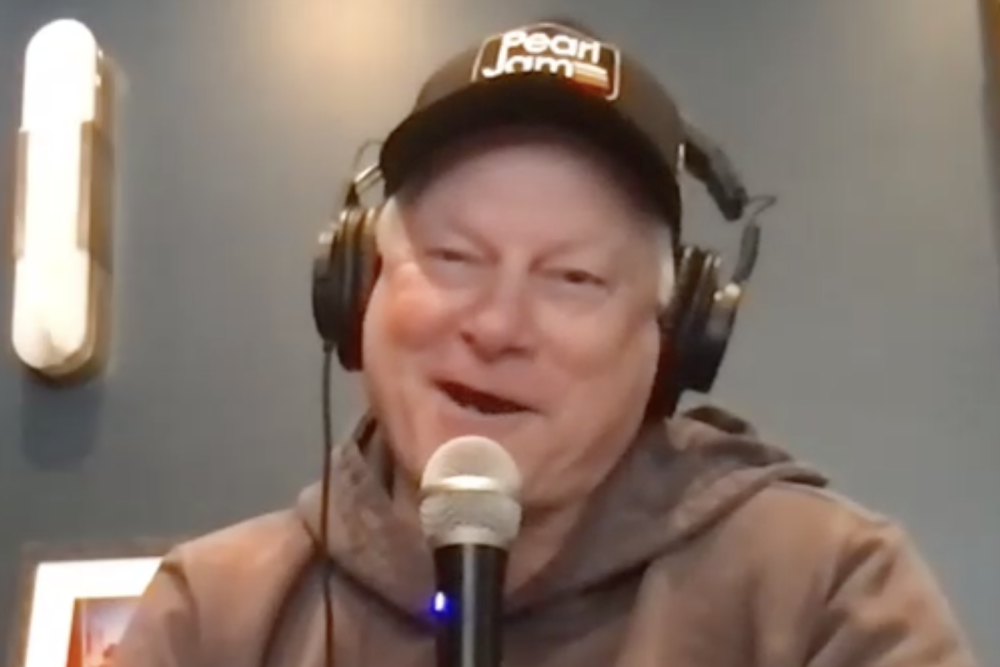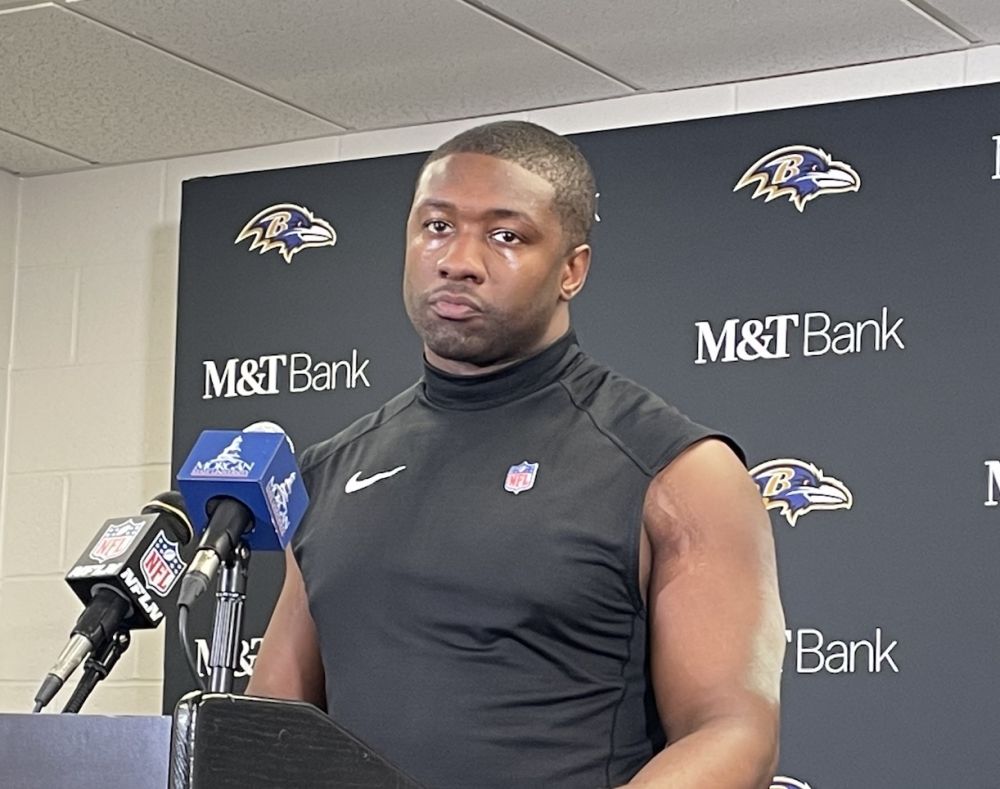Before the draft, the Ravens were convinced they could deal back as many as 10 picks and still grab Starks. Remember, they were desperately looking for more picks to supplement their third- and fourth-round losses. The Ravens would have been glad to deal out and move back, and the Eagles feared who that might be and what they would want.
But now at the risk of losing Starks to Philly at No. 11, they were having serious second thoughts. If they dealt out and someone did take Thomas, would Philly really take Starks? What have you gained if you get an extra pick or two if you lost the guy you really wanted? The only guy you really wanted? Chavous was a nice player, but you couldn’t build a draft around him. And Dyson wouldn’t make an instant impact, even if you got him later in the first round.
The Ravens got nervous about the Eagles rumors. Newsome quickly acquiesced – Duane Starks was coming to Baltimore.

Savage later joked with The Sporting News in an extensive interview that examined the Ravens war room procedure that weekend that he was wearing his tuxedo to the draft because “Ozzie Newsome is marrying Duane Starks today.” Even Newsome acknowledged that perhaps Starks was taken a little higher than expected, but he got his man and that’s all that mattered. Despite Starks’ enduring the typical on-the-job-training that most young cornerbacks get in the NFL – learning through embarrassing failure on Sundays at the hands of cagey veteran wide receivers – Newsome will never file for divorce. Starks had 18 interceptions in his first three seasons in the NFL and will be wearing a Super Bowl ring almost as big as his diminutive frame for the rest of his life. When Starks high-stepped into the end zone that sun-drenched day in Tampa after picking off Giants quarterback Kerry Collins, rest assured the happiest man in that stadium was Newsome.
By not dealing the pick and moving back, the Ravens became even more zeroed in on their “other” first-day pick (No. 42) and getting a weapon for Harbaugh in the passing game.
There were three names on their big board when the pick started getting close, two of them actually tight ends, not receivers. Cameron Cleeland of Washington and Oklahoma’s Stephen Alexander topped their wish list along with Oregon’s speedy wide receiver Patrick Johnson. Cleeland was the total package, a big, blocking end who could catch the ball a little. Johnson was their next choice, mainly because of his versatility. Even if he didn’t make it right away into the starting lineup, they knew he could return kicks and run like hell. He wasn’t the most natural receiver – he really was a star at track and field more so than football – but he was tough, attentive and would work hard to get better. He had a good attitude. Alexander was a fallback, mainly because he wouldn’t be much of a pass receiver, and was not truly an offensive weapon.
The Saints made the Ravens’ choice easy, selecting Cleeland at No. 40. Pat Johnson was trading in his Duck green for Raven purple eight minutes later.
Then, a depression set in over the Ravens war room. The braintrust was out of picks and would spend the remainder of Saturday merely as spectators.
There have been 10 days of actual drafting in the first five years of the Newsome-Savage era. If there was one day the organization could request for a “do over,” Sunday, April 19, 1998 would be that day.
Savage now calls that day “an embarrassment, an absolute disgrace…the worst day of my life.”
On that Sunday, the Ravens drafted in order:
124. Martin Chase, DT, Oklahoma
133. Ryan Sutter, S, Colorado
154. Ron Rogers, LB, Georgia Tech
164. Sammy Williams, T, Oklahoma
241. Cam Quayle, TE, Weber State
Only one ever made it into a Ravens uniform and none made an impact of any significance.
It’s not like the path from No. 124 to Mr. Irrelevant himself, Quayle, was littered with future Pro Bowlers. But along the way the Ravens passed on a myriad of guys that if you follow the NFL, you will have at least heard of or seen on TV.
Matt Birk, Chris Fuamatu-Ma’afala, Fred Beasley, Matt Hasslbeck, Alvis Whitted, Ken Oxendine, Pat Tillman, Jonathan Linton and Benji Olson were all taken after pick 125. But to be quite honest, even one of those names would have appeased Savage and not made him feel “sick, just sick to the pit of my stomach.”

The biggest flop of all was Rogers, who at 6-0 and 245, could have at least made it through the team’s first mini-camp without embarrassment. Rogers arrived just five days after the draft, looking relatively lumpy. He walked on the field and in his first set of reps, covering an undrafted free agent rookie running back, caught the eye of David Modell. And not for the right reasons. Modell, a real fan at heart and certainly not one to stick his nose into the Xs and Os much at all, had seen enough from the first play.
“That guy can’t play at all,” Modell said to some scouts as any fan would. “He’s horrible! Did we draft him?”
That day on the field at Owings Mills the infamous organizational “Ron Rogers Rule” was spawned. The rule states very simply, in the fine Ravens tradition of Edgar Allan Poe: “Nevermore.”
“I will personally never let that happen again,” Savage told all who would listen.
Savage threw himself back into his work and glowingly spoke of the third weekend of April 1999 as “The Redemption Draft.”
Redemption would be readily available in 1999. Around the NFL as the college season wore on, it would take on a different pseudonym: “The Quarterback Draft.”
Five quarterbacks would be selected on April 17, 1999, and the Ravens would have their shot at one if they were so inclined.
While the Ravens were playing out the final games of the Marchibroda era, and David Modell was traversing America via the phone lines looking for who would eventually be Brian Billick to lead the team, Savage was trying to find future difference makers on college campuses.
Late in the 1997 season, while Savage was in Tucson, Ariz., on the field prior to a game where the Wildcats were hosting Oregon State, No. 11 caught the eye of just about everyone.
“He was big and strong, especially for a junior at the time,” Savage said. “He looked like a man out there. More like a safety or a linebacker than a cornerback.”
Chris McAlister was, in the minds of the Ravens, an absolute can’t-miss prospect. Savage’s first thought, even on that afternoon more than 18 months before he’d be drafted, was “nice player, too bad we’ll never get him. Even with the quarterbacks coming out, I thought we’d have to have one of the top three picks in the draft to sniff him.”
Once the season was complete and Billick was hired, the Ravens got realistic about having the 10th pick in the draft and started looking at players and evaluating their own talent.
Billick’s immediate goal was to improve the offense and help it catch up with a young, but quickly improving defense. Part of that philosophy wasn’t about waiting on quarterbacks Tim Couch, Akili Smith, Donovan McNabb, Daunte Culpepper or Cade McNown to develop. Much to the chagrin of Savage and his scouts, Billick and Newsome tapped into “The Redemption Draft” by trading the Ravens’ third-, fifth- and sixth-round picks away for quarterbacks Scott Mitchell and Tony Banks along with tight end Lovett Purnell. The Banks trade happened on Draft Day when it became clear the team wouldn’t use its first pick for a quarterback.
All of a sudden “The Redemption Draft” would have to be accomplished with just six picks on Draft Day.
On April 17, 1999, the Ravens were still in dire need of help at the wide receiver position and the team’s secondary was smarting, getting beaten frequently on long passes and breakdowns. Starks was a nice player, but was paired with DeRon Jenkins, having two small cornerbacks was a major liability against the Jimmy Smith-Keenan McCardell type combos of the NFL.
The team knew that the big three quarterbacks – Couch, McNabb and Smith – would be gone along with running backs Edgerrin James and Ricky Williams, but after those players it became more murky.
The Ravens were zeroed in on three players and would have been delighted with any of them. Tory Holt was a wide receiver from North Carolina State, a quality character guy with the ability to run strong routes who made everything appear effortless. Ohio State’s David Boston, another wide receiver, was a big, strong guy whose size would prove to be a plus against smaller defenders. McAlister, at 6-1 and 205 pounds and running a 4.41, was a difference maker, a guy ESPN draft expert Mel Kiper called a “super blue chipper, destined for greatness.” He ran faster than guys two inches shorter and 25 pounds lighter. Guys that had his size, speed and tackling ability were just not found in the NFL at cornerback. They were turned into safeties, mainly because most aren’t fast enough.



























